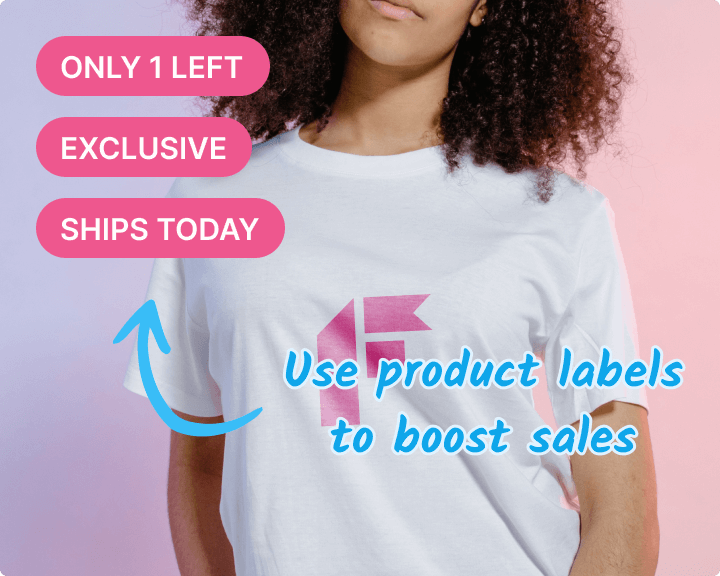How To Start a Shopify Pet Store

The global market for pet products and services is expected to be worth a cool $400+ billion by 2028, so it’s hardly surprising that the pet niche is a popular choice among would-be e-commerce entrepreneurs.
If you’re one of them, you’re in the right place. In this article, we’ll explain:
- Why the pet niche is so attractive
- How to start a Shopify pet store
- Best practices for building a successful pet store
Plus, we’ll share real-world examples of stores that are making bank selling to pet owners.
Let’s get into it…
Is A Pet E-Commerce Business Profitable?
In a word: yes.
Pet owners love splashing the cash on their animal friends. The average American cat owner spends $687 a year on their feline companion, rising to over $1,200 annually for dog owners.
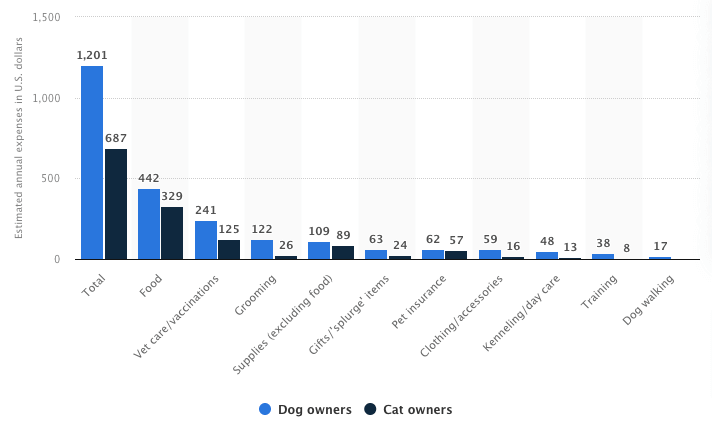
Best of all, as you can see from the above graphic, that spending is spread across a wide range of niches. Essentials like food and veterinary care account for the bulk of the money, but there’s also plenty of discretionary spending — things like grooming, gifts, and clothing.
Because who doesn’t love seeing a pug dressed as Chucky?
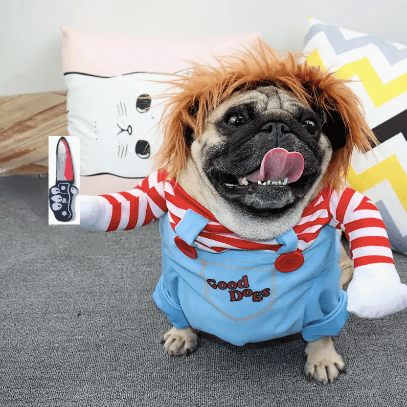
All those different product categories give prospective pet store owners the opportunity to focus on a highly specific niche, helping them target qualified customers while avoiding competition with larger, generalist retailers.
Why Open a Pet Business on Shopify?
So we’re agreed that the pet niche is a smart choice for anyone looking to open an online store. But why start an online store on Shopify rather than a different platform, like WooCommerce or Magento?
Let’s consider the key benefits of Shopify:
- Easy to get started: With its wealth of prebuilt themes, Shopify makes it simple to build an online store, even for people with no coding skills.
- Relatively cheap: While Shopify’s enterprise-level plan, Shopify Plus, costs $2,000+ per month, you can create an attractive, high-performing online store for as little as $29 per month.
- Highly customizable: It’s easy to build a store that’s totally unique to the needs of your business and audience, thanks to Shopify’s website editor and huge number of apps.
- SEO-friendly: Shopify boasts various built-in SEO features — like editable title tags, meta descriptions, and URLs — to help your store stand out in search results.
- Fully hosted: Because all Shopify stores are hosted on Shopify’s servers, there’s no need to pay for an external hosting provider.
Pro tip: Shopify’s great — but is it right for you? Find out more in our article: Shopify Pros and Cons: Unbiased Insights.
How To Start a Shopify Pet Store
Decided Shopify is the best e-commerce platform for your online pet shop? Let’s talk through the steps required to design, build, and launch your store:
Step 1. Understand the Pet Owner and Conduct Market Research
The first step for launching any online store, regardless of industry, is to understand the market and who you’re targeting.
Start by honing in on a niche. Because if you start a generalist pet supplies business, you’ll be competing with massive brands like Chewy and PetSmart. Even with the best will in the world, you’re probably not going to win that battle.
An attractive niche is one that has:
- Lots of potential customers
- Tons of growth potential
- Solid profit margins
One of our favorite ways to find high-potential niches is to browse Flippa, a marketplace for buying and selling online businesses. But you’re not using it to buy; you’re looking for the types of niches that real, revenue-generating pet stores have adopted.
Search for a keyword like “pet” or “dog”, then limit the results using the following filters:
| Filter | Selection |
| Revenue-generating | Yes |
| Asset type | Websites and online businesses
Amazon stores |
| Website types | E-commerce
Dropship Digital products |
Then simply browse the listings and see what comes up.
For instance, this store…

…is making a net profit of ~$6,000 a month selling personalized and custom pet gifts. Not too bad.
Be sure to check the performance figures to identify any seasonal trends. For example, the pet gift store we found generates the vast majority of its revenue at the back end of the year:
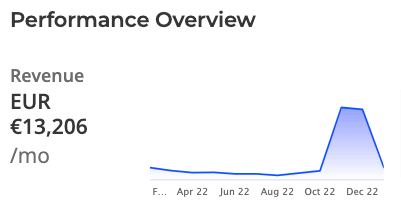
Could you afford to start a business that’s so reliant on the holiday season? Or would you prefer something more evergreen?
Take your time exploring the results, draw up a list of potential niches, and then choose your favorite.
Pro tip: For more profitable niche ideas, check out our guide: What to Sell on Shopify.
Step 2. Create a Business Plan
A business plan is a detailed document that spells out the goals of your pet store and how you hope to achieve them. Think of it as a roadmap to help you stay focused on big-picture objectives rather than getting distracted by short-term opportunities.
Your pet store business plan should include the following sections:
- Executive summary: A brief overview of your store’s objectives and overarching mission.
- Business description: Essential information about your business, including your niche, the products and/or services you sell, and your business model.
- Market analysis: A breakdown of the market size, who you’re targeting, and which other stores you’re competing with.
- Organization and management: Simply put, who’s on your team, and what roles do they perform?
- Products and services: Further detail about the specific products and/or services you sell.
- Marketing and sales strategy: How do you plan to promote your store and reach new customers? This might include details about competitive pricing.
- Funding request: Are you seeking funding from an external investor? This is where you spell out how much money you’re asking for, how you plan to spend it, and your desired terms.
- Financial projections: A roundup of your startup costs, how much revenue you expect to generate for at least the first 12 months, and when you expect to break even.
- Appendix: A space for any other supporting documentation, such as any charts, graphs, or tables that back up other sections of your business plan.
Step 3. Sign Up for Shopify
You’ve found your niche and written a business plan, so it’s time to sign up for your FREE 3-day Shopify trial, which (should) give you enough time to learn the basics of the platform and build a functional store.
Shopify won’t ask for your payment information at this stage, but they do ask for some initial information about your business, including:
- Whether you’re already selling (online or in-person) or just starting out
- Which channels you plan to use to reach your audience
- What types of products or services you’re planning to sell

Answer as accurately as you can, but don’t worry if you change your mind down the line — nothing at this stage is legally binding!
Step 4. Design and Build a User-Friendly Shopify Store
Now that you’ve begun your free trial, you can get started with building your Shopify pet store.
Pro tip: Be sure to check out our Shopify Get Started guide before you begin building your pet store (or at least use it as a reference guide while you bolt your store together)..
There are a few general points to bear in mind to help you design a user-friendly store:
- Choose a mobile-optimized theme: Over half of global web traffic is mobile, so you want a theme that works well on mobile devices. All of Shopify’s “official” themes are mobile-friendly.
- Highlight your unique selling points and benefits: As soon as someone lands on your website, you want them to understand what you do and why they should buy from you.
- Write engaging and informative pet product descriptions: Don’t just list a product’s specifications — explain the specific benefits it offers to your target audience.
- Create a smooth path to purchase: Don’t make shoppers jump through too many hoops to convert. Make their life easier by optimizing your store navigation and leveraging features like site search.
Pro tip: For advice on turning store visitors into paying customers, check out our guide: How To Increase Conversion Rates on Shopify.
Step 5. Launch Your Shopify Pet Store
In your Shopify admin, you’ll find a useful section titled Things to do next, which sets out everything you need to get your store live:

As well as the fundamentals (like adding products and setting shipping rates), it includes some helpful troubleshooting steps to ensure everything’s running smoothly — such as placing a test order.
Once you’ve ticked all the necessary boxes, you’re ready to launch your pet store. Congratulations!
Step 6. Promote Your Shopify Pet Store
Building a high-converting Shopify store is only the first step in creating a successful online pet supplies business. Next, you need to work on your marketing to target the right kinds of customers and persuade them to visit your store (and, hopefully, buy something).
There are plenty of promotional tactics and strategies available to Shopify pet store owners, including:
SEO
Search engine optimization is a complicated game. But, to cut a long story short, it’s essentially about finding relevant keywords with plenty of search volume, then targeting them through the right web pages.
Pages that sit deeper in your site architecture should target more specific keywords. Here’s how this looks for Grace's Organic Dog Food, a pet store that sells — you guessed it — organic dog food:
PPC
Pay-per-click (PPC) advertising is kind of like SEO, because both involve targeting keywords.
The big difference is that with PPC, you tell Google (or a different search engine) how much you’re prepared to pay for a single click from someone searching for your target keyword. Hence the name “PPC”.
As such, PPC allows you to start generating traffic immediately, as long as you’ve got the budget to pay for it, whereas SEO can take weeks or months to produce results.
Social
Social media is an effective channel for raising awareness of your brand, building an online community, and sharing your latest promotions. And it’s not just about awareness — you can also use social to drive store clicks and sales.
For example, in this post, Chewy used Instagram to promote its expansion into the Canadian market:
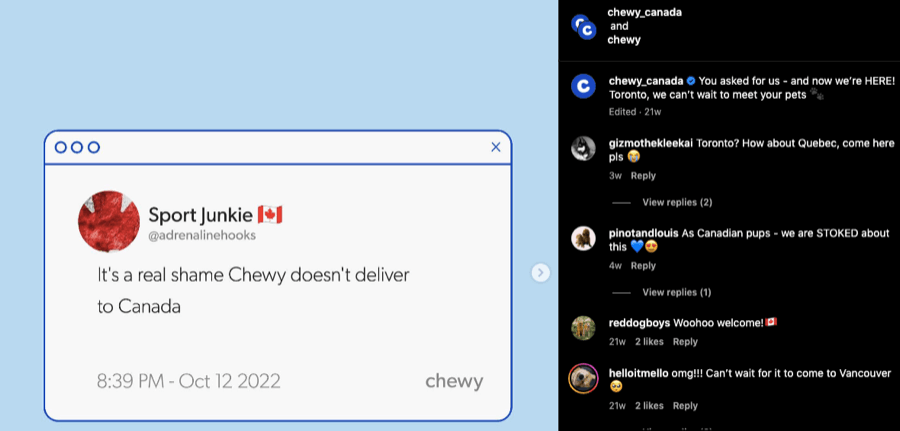
Any Canadian dog parents excited to try Chewy’s products can then click the link in the brand’s Instagram bio…

…where they can click straight through to Chewy’s online store.
Email delivers the highest return on investment of any marketing channel: a whopping $36 for every $1 spent. The only catch is that you need to persuade potential customers to hand over their email addresses before you can take advantage of this cost-effective promotional strategy.
That’s why many Shopify pet stores use onsite popups to generate e-commerce leads. Just like pet portrait store West & Willow, which offers visitors the chance to win a discount of up to 20% in exchange for their email address:
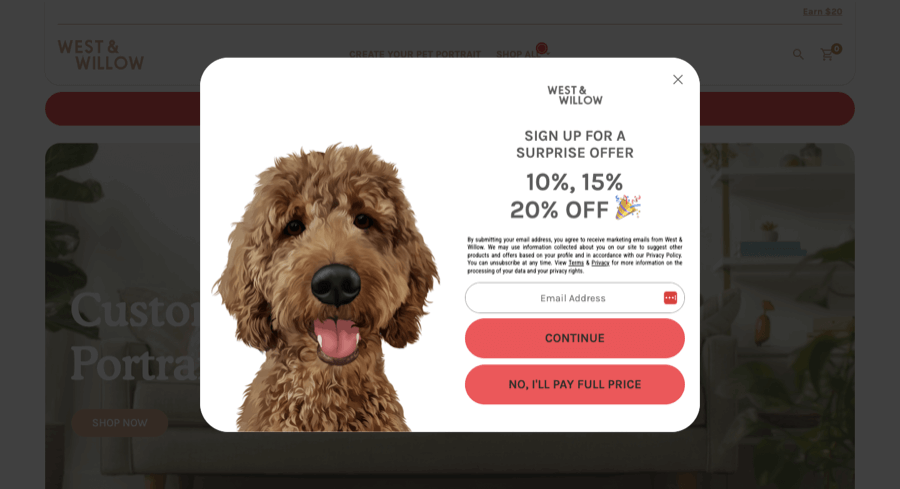
Affiliate Marketing
Affiliate marketing is one of our favorite promotional strategies because it essentially involves getting other people — like bloggers and social media influencers — to do your promotion for you, in return for a commission on any sales they generate.
Sounds good, right?
Pro tip: Find out more about affiliate marketing (and whether it’s right for you) in our guide: Affiliate Marketing vs Dropshipping: Which One is Better?
Step 7. Create Urgency and Scarcity
“Urgency” and “scarcity” are two of a Shopify store owner’s favorite words. Used effectively in your messaging, promoting urgency and scarcity can:
- Increase the perceived value of your products
- Build a sense of exclusivity around your brand
- Convince shoppers to buy right now
Boost your Shopify sales by up to 175% automatically with Flair
- Highlight products with badges
- Promote sales with banners & countdowns
- Automate with conditions and scheduling

Boost your Shopify sales by up to 175% automatically with Flair
- Highlight products with badges
- Promote sales with banners & countdowns
- Automate with conditions and scheduling
 Try Flair for FREE
Try Flair for FREE
Step 8. Monitor and Improve
Don’t expect to launch your Shopify pet store then sit back and watch the profits roll in forever.
Every e-commerce business requires constant monitoring to optimize performance, from A/B testing different landing pages to targeting different keywords and experimenting with new promotions. Plus, search engines and social platforms change their algorithms constantly, making it hard to retain — let alone grow — your traffic and sales.
All of which means you’ll have to keep a close eye on your analytics tools to see what’s working (and what isn’t).
Tips To Ensure Your Shopify Pet Store is Successful
The most successful Shopify pet stores share a few common traits. Here’s how to replicate them:
Pick a Suitable Shopify Theme
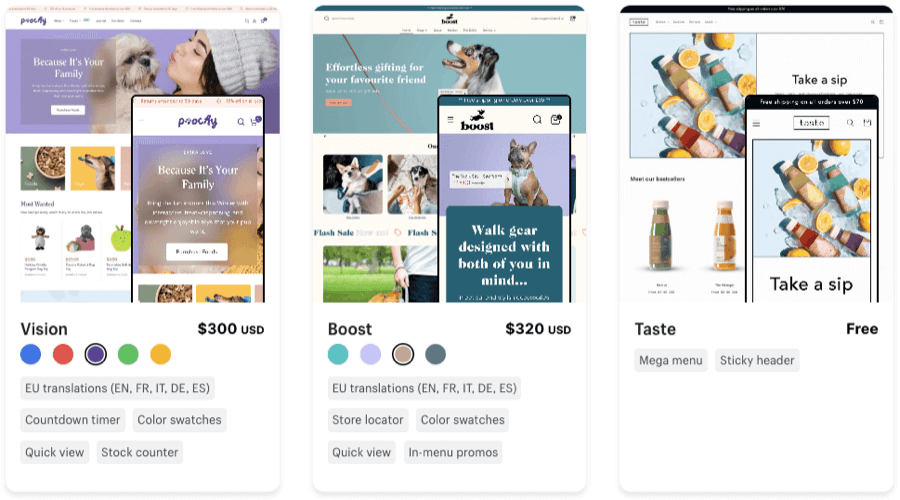
We’ve already mentioned that you should pick a mobile-friendly Shopify theme. But there are some other elements to choosing a theme that works for your store:
- Does it fit your niche? Shopify lets you filter themes in its store by industry, so you’ll likely want to choose one in the pet supplies niche.
- Does it have the necessary features? Not all themes do the same stuff — far from it. If you need specific features (like breadcrumbs or quick-view capabilities or in-menu promos), you’ll rule out a lot of potential themes.
- Does it fit your product catalog? Some basic themes can only handle tiny product catalogs (i.e. up to nine products). Make sure you choose one that can fit your whole range.
- Does it fit your budget? If you need a lot of sophisticated features and have a large product catalog, you likely won’t find many (or any) free themes that are up to the task. Paid theme prices in Shopify’s theme store range from $140 – $400. Would you rather pay a higher price or sacrifice functionality?
Have Clear CTAs Throughout the Site
Calls to action (CTAs) play a key role in steering shoppers toward your more attractive products and best deals. So, you should add them to prominent positions across your website.
For instance, what’s one of the first things you see when landing on the homepage of Frenchie Bulldog, a pet store that sells dog harnesses and leashes?
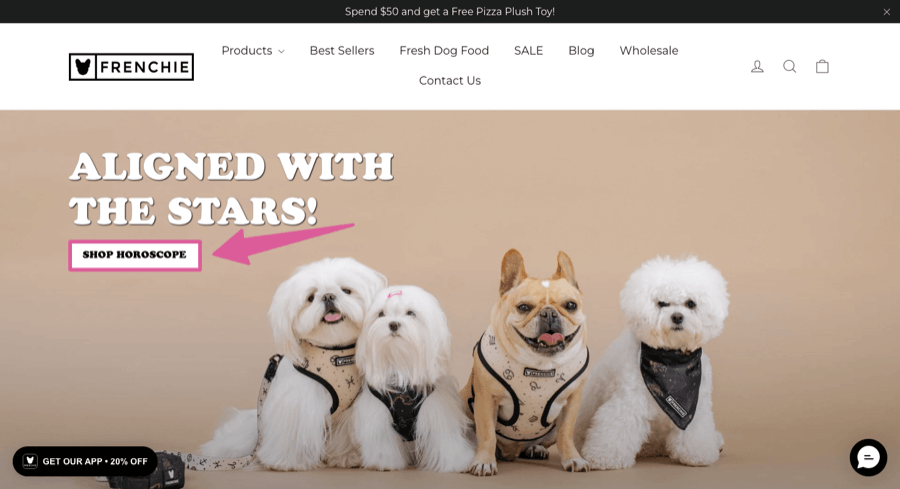
That’s right: a CTA for its latest product collection.
Use Fantastic Imagery
If your Shopify pet store looks hideous, it reflects badly on your whole business. A lot of shoppers will think: if they’re this sloppy about web design, why should I trust them to look after my card details or ship my purchase on time?
One way to level up your design is to use high-quality imagery.
Don’t worry if you’re not a pro photographer or graphic designer; keep it simple by taking product photos against a white background (and remember to capture products from multiple angles). And when it comes to sourcing other imagery for your site, you can lean on:
- Stock image galleries like Freepik and Unsplash
- Simple graphic design tools like Canva and Design Wizard
- Generative AI tools like DALL·E 2 and DeepAI
Pro tip: Don’t forget to optimize your images to ensure they display correctly across your site, load fast, and show up in relevant search results. Learn how in our guide to Shopify image optimization.
Use a Catchy Tagline
You don’t (necessarily) have to come up with something as enduring as “Just Do It” or “I’m Loving It”.
But if you can write a catchy tagline, it’s a good sign that you’ve found a clear niche and have an easily understandable value proposition — which makes it far easier to promote your store.
Need a little inspiration? Check out your competitors’ Instagram bios:

Provide Amazing Customer Service
More than half of Americans would pay more if they know they’ll receive great customer service, while 83% of consumers feel more loyal to brands that respond to and resolve their complaints.
So, if you deliver excellent support, you’re more likely to retain your customers — and they’ll even pay a higher price for your products!
Ideas for Your Shopify Pet Store
There’s no shortage of niches within the broader pet supplies market. Here are some options for your Shopify pet store:
Pet Food
If you’ve ever spent any time around a cat or dog (or any other pet), you’ll know they love to eat. Which explains why the global pet food market is expected to be worth $190+ billion by 2029 🤯.
Pet food is a broad niche that’s dominated by massive names like Royal Canin and Purina, so your best bet is to narrow your focus by targeting a sub-niche like:
- Organic pet food
- Vegan pet food (yep, it exists)
- Raw pet food
Dog Training
One in four dog owners say training is the biggest challenge of caring for a canine companion, so there’s definitely money to be made in dog training. Here are some ideas for dog training items you can sell in your Shopify store:
- Physical products: Training-related materials like books, DVDs, and magazines.
- Digital products: Online dog training courses, live video sessions, and e-books.
While you don’t need a college degree to make it as a dog trainer, potential customers will definitely want to see some trust factors (like reviews and testimonials) on your store.
Pet Clothes
Pet clothes fall into two main categories:
- Practical: Winter gear, wet-weather clothing, life jackets, etc.
- Just for fun: Dress-up outfits for Halloween, Christmas, birthdays, and other occasions.
Either way, this niche is highly seasonal. For instance, the vast majority of search activity around “dog clothes” happens in winter:
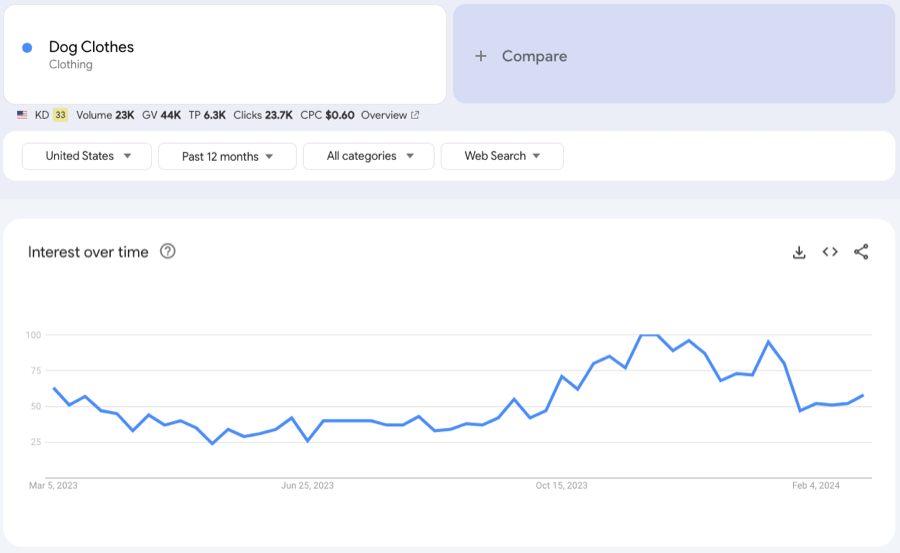
Like with pet food, we’d recommend niching down further if you’re planning to enter the pet clothes space. Someone shopping for a hardy cold weather coat for their precious pupper might not be interested in seeing a bunch of doggo-friendly Halloween costumes.
Pet Toys
Back in my day, your average cat or dog was happy rolling around with a ball of twine or chasing a stick.
Today’s furry friends evidently have higher expectations — at least if the sheer wealth of pet toy options is anything to go buy. Laser pointers; plush toys; strategy games for dogs… the list goes on.
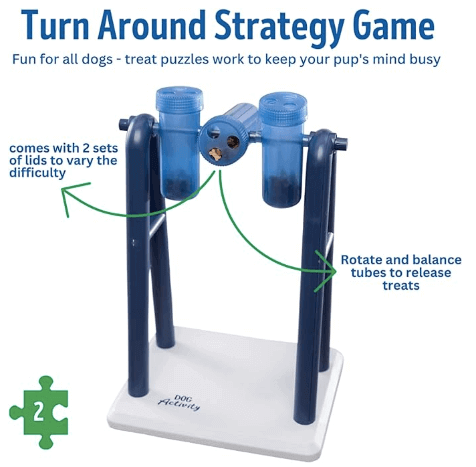
Which explains why the global pet toys market is projected to exceed $18 billion by 2032, making this another niche with tons of potential.
Pet Beds
Dogs sleep for up to 14 hours a day and cats for up to 16 hours, so it’s only reasonable to buy them a nice, cozy bed.
Again, there’s no shortage of money-making potential in this niche, with the global market for pet beds set to be worth over $7 billion by the end of 2031.
Dog Walking
Most dogs need at least a couple walks a day to keep them healthy, which makes dog walking a smart niche for a Shopify pet store.
There are plenty of dog walking related products you can sell, from leashes and harnesses to treat pouches and glowing collars for night walks.
Pet Grooming
Grooming is a constant priority, given pets’ propensity for getting covered in mud and scratching up your furniture.
There’s plenty of variety in this pet store niche, like bath supplies, towels, hair dryers, scissors, clippers, nail cutters, and more.
Best of all, products like shampoo and conditioner have tons of repeat purchase potential, helping you build a loyal audience of regular customers.
Successful Shopify Pet Store Examples
We’ve shown you how to build a Shopify pet store, given you plenty of tips for running a successful online business, and shared some of our favorite pet-themed product niches. The only thing you’re missing is a little real-world inspiration from high-performing pet stores.
Look no further:
Heads Up For Tails

- Shopify theme: Dawn
First up is Heads Up For Tails, a generalist pet store for dogs, cats, and small animals. It sells everything from food and treats to beds, clothing, and other accessories. On the downside, this means they’re competing with some massive names. But on a positive note, if you buy from Heads Up For Tails once and you’re satisfied with the service, you can go back to them for all your future pet care needs.
Rowan

- Shopify theme: Streamline
Rowan is an example of a Shopify pet store that’s found a profitable niche: hair care products for dogs. This narrow focus helps it rank in the top #10 on Google for valuable keywords like “dog conditioner”, alongside far bigger names like Petco and Chewy.
K&H Pet Products
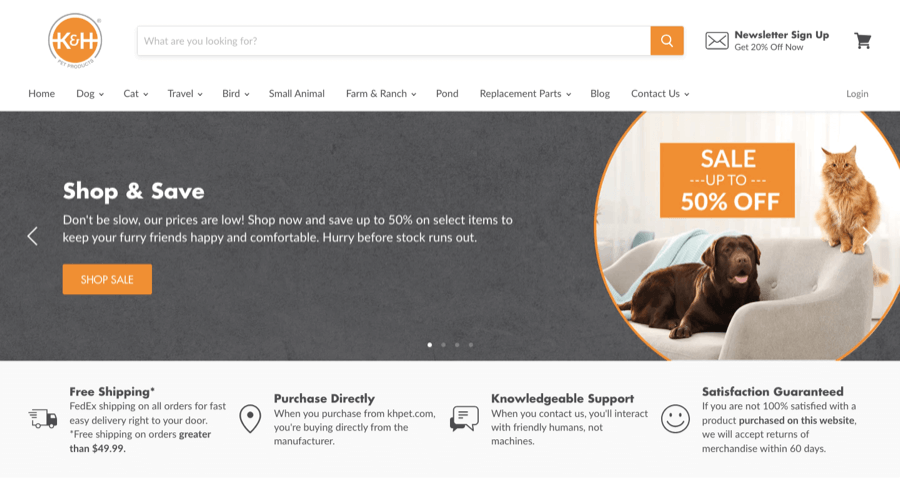
- Shopify theme: Empire
K&H Pet Products is another super-niche Shopify pet store, this time specializing in heated and cooled beds for cats and dogs. Like Rowan, its narrow but deep topical authority helps K&H outrank far bigger brands — including Petco and Pets at Home — for high-value keywords like “heated dog bed”.
Other FAQs
What Sells Best in a Pet Shop?
Research shows that the best-selling pet product category is food. In the US, dog owners spend an average of $442 per year on pet food, while cat owners shell out $329. Other profitable categories include:
- Vet care and vaccinations ($241/year for dogs, $125/year for cats)
- Grooming ($122/year for dogs, $26/year for cats)
- Non-food supplies ($109/year for dogs, $89/year for cats)
- Gifts and “splurge” items ($63/year for dogs, $24/year for cats)
- Clothing and accessories ($59/year for dogs, $16/year for cats)
Can You Sell Pet Products on Shopify?
Yes! Shopify is a great fit for anyone thinking of opening an online pet store, allowing you to sell everything from pet food to accessories to services like dog training. The only pet-related products you can’t sell on Shopify are pharmaceuticals and actual, live animals. If you plan on selling flying squirrels or echidnas, you'll have to do it outside of Shopify.
Increase sales by up to 175% with product badges
- Use product labels to help products sell faster.
- Highlight best sellers, new arrivals, almost gone, and more.

Increase sales by up to 175% with product badges
- Use product labels to help products sell faster.
- Highlight best sellers, new arrivals, almost gone, and more.
 See the guide
See the guide




